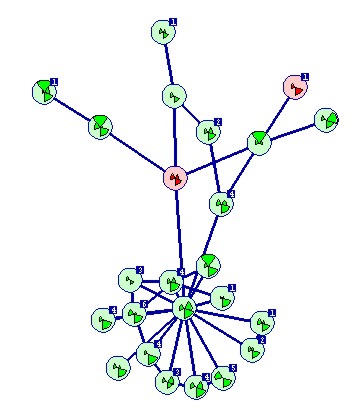CSCI/MATH/STAT 732
INTRODUCTION TO BIOINFORMATICS

INSTRUCTOR
- Name: Anne Denton
- Office: IACC 258 A26
- Phone: 231-6748
- E-mail:
anne.denton@ndsu.nodak.edu
- Office hours: MW 10:30 a.m. - 12:00 p.m.
LECTURES
- MWF 1:00 - 2:00 p.m.
- IACC 106
TEXTBOOK (REQUIRED)
Dan Krane, Michael Raymer, Fundamental Concepts of
Bioinformatics, Benjamin Cummings, 2003.
COURSE DESCRIPTION
An introduction to the principles of bioinformatics including statistical techniques for the analysis of one or more gene sequences, and computational techniques for knowledge discovery from biological data.
COURSE OBJECTIVE
The objective of this course is to provide the
student with
sufficient understanding of the principles of bioinformatics to pursue
research
topics in collaboration between computer scientists and
biologists.
Representative algorithms to solve a variety of bioinformatics problems
will be discussed.
Scope
- Introduce problem domain
- Discuss representative algorithms
- Focus on concepts rather than mathematical representation or computer implementation
- Address breadth of bioinformatics issues
- From conventional sequence alignment
- To data mining of biological data
- Get students started on bioinformatics research
Topics include
- Concepts in bioinformatics
- Phylogenetic trees
- Clustering of gene expression data
- Sequence analysis and comparison
- Biological databases
- Statistical techniques
- Protein secondary structure
- Biological networks and pathways
PREREQUISITES
- Graduate standing or permission by instructor
- High school mathematics
- There will be no programming in assignments (Students working on the project as computer scientists will, however, be required to program)
- No biological background will be expected
GRADING
| Points each |
Points total |
||
|
2 |
Exams |
100 |
200 |
|
5 |
Homework Assignments |
20 |
100 |
|
1 |
Project |
100 |
100 |
| 1 |
Final Exam (optional) |
(100) |
|
|
Total |
400 |
||
The cut-off will not be higher than 90% for A, 80% for B, 70% for C,
and 60%
for D, but may be lower.
Project
The course will
include a
project that will be done in groups that consist of a biologist
subgroup of 1-3
students and a computer scientist subgroup of 1-3 students. If
you think
you could belong to either group you can chose which part to do.
The
biologist subgroup will find data, explain, and document it, and
explain
interesting questions to the computer science subgroup. The
computer
scientist subgroup will implement an algorithm on that data.
Eventually
the biology subgroup will explain the results together with the
computer
science subgroup. Simplified dataset-algorithm combinations will
be
provided to seed the process but students are by no means limited to
those. Please contact me as soon as possible with any ideas you
have.
PLEASE NOTE: Any student with disabilities or who needs special
accommodations in this course is invited to share these concerns or
requests
with the instructor as soon as possible.
PLEASE NOTE: All work in this course must be completed in a
manner
consistent with NDSU University Senate Policy, Section 335: Code of
Academic
Responsibility and Conduct (http://www.ndsu.nodak.edu/policy/335.htm).
Course Content
| Week 1 (Jan 8) |
Concepts of Bioinformatics |
|
|
| Week 2 (Jan 15) (Mon Holiday) |
Algorithms in Bioinformatics |
|
|
| Week 3 (Jan 22) |
Sequence Alignment |
|
Assignment 1
|
| Week 4 (Jan 29) |
Alignment of More Than Two
Sequences |
|
|
| Week 5 (Feb 5) |
Biological Databases and
Database Search |
|
Assignment 2
Due Feb 9 |
| Week 6 (Feb 12) |
Phylogenetic Trees |
|
|
| Week 7 (Feb 19) Mon Holiday |
Clustering Gene Expression Data |
|
Assignment 3
|
| Week 8 (Feb 26) |
Classification in Bioinformatics |
|
Presentations of literature
review for project
Starting Feb 16 |
| Week 9 |
Exam 1
(Mar 7) |
||
| Spring
Break |
|||
| Week 10 (Mar 19) |
Motif Discovery |
|
|
| Week 11 (Mar 26) |
Hidden Markov Models |
|
|
| Week 12 (Apr 2) |
Protein Structure Prediction |
|
Assignment 3
|
| Week 13 (Apr 9) |
Genome Rearrangements |
|
|
| Week 14 (Apr 16) |
Interaction-, Regulation-, and Metabolic Networks |
|
Assignment 5
|
| Week 15 |
Exam 2
(Apr 25) |
||
| Week 16 (Apr 30) |
Project
Presentations |
Project Report due May 4 |
|
| Finals
Week |
|||
Further Reading
[1] T.A. Brown,
"Genomes," John Wiley & Sons,
Excellent introduction to genomics.
[2] J.C Setubal , J. Meidanis,
"Introduction
to computational Molecular Biology," PWS Publishing Company,
Important algorithms, precise treatment.
[3] R. Durbin, S. Eddy, A. Krogh,
G. Mitchison, "Biological Sequence
Analysis,
Probabilistic Models of Proteins and Nucleic Acids,"
Covers Hidden Markov Models and related probabilistic models comprehensively .
[4] A. D. Baxevanis,
B.F.F.
Ouellette, "Bioinformatics, A Practical Guide to the Analysis of Genes
and
Proteins," 2nd Edition,
Extensive collection and
description of
available databases and tools.
[5] H.-W. Mewes , H. Seidel, and B. Weiss, "Bioinformatics and
Genome
Analysis," Springer,
Useful collection of
bioinformatics
papers.
[6] G. Gibson and S.V. Muse, "A Primer of Genome
Science," Sinauer Associates, Inc.
Publishers,
Textbook for Genomics
course.
Covers some bioinformatics as well!
[7] A.M. Campbell and L.J. Heyer,
"Genomics, Proteomics, and Bioinformatics," Benjamin Cummings,
Techniques and practical
examples.
Focus on Genomics and Proteomics.
[8] T.H. Cormen, C.E.
Leiserson, and R.L. Rivest,
"Introduction to Algorithms," The MIT Press,
Standard Computer Science
textbook on
algorithms.
[9] T. Hastie, R. Tibshirani, and J. Friedman, "The Elements of
Statistical Learning: Data Mining, Inference, and Prediction,"
Springer,
Data mining text that
closes the gap to
machine learning and statistics.
[10] I.H. Witten , E.
Frank,
"Data Mining: Practical Machine Learning Tools and Techniques with Java
Implementations," Morgan Kaufmann,
There are many data mining texts around.
This one
is easier to read than [9].
[11] "Bioinformatics" http://bioinformatics.oupjournals.org/
Current editions: only abstract, older editions
(approx.
10mo. old): full text accessible